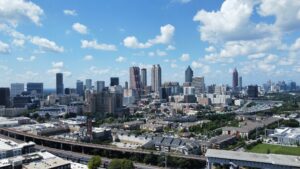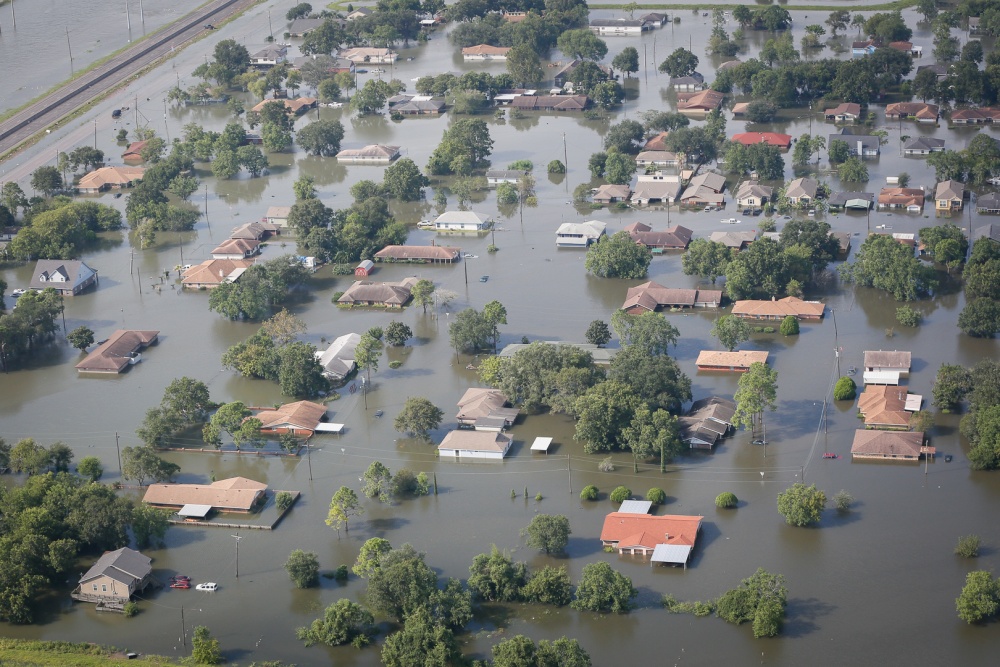
Earlier this month, on June 2, 2025, Atlanta’s City Council unanimously passed a state-of-the-art ordinance to require cool roofs throughout the whole city, immediately propelling Atlanta to the forefront of local climate adaptation measures. The new requirements will help make Atlanta cooler, improve its air quality, and lower residents’ energy bills. They also provide a model for other cities looking to advance climate adaptation legislation.
Cool roof requirements typically set standards for how much incoming solar radiation roofing materials must reflect—defined in terms of solar reflectance, thermal emissivity, or a calculated combination of the two expressed as solar reflective index (SRI). These are usually expressed as minimum figures after a roofing product has been in place for three years. For each of these metrics, higher standards mean less heat absorbed and retained by the roof, which corresponds to lower temperatures in the building below and the surrounding area. Cool roof requirements are also, but less commonly expressed as initial reflectance figures measured at the time roofing materials are installed. Those capture the same types of reflectivity measures up front but can allow for materials that become less reflective after years of weathering in place causes chemical changes in the asphalt of shingles and after reflective granules begin eroding from their surface.
Prior to adopting its new requirements, Atlanta required commercial buildings citywide to have either a 3-year aged solar reflectance of 0.55 and a 3-year aged thermal emittance of 0.75 or a 3-year aged SRI of 64. In three special purpose zoning districts, both commercial and residential buildings with low slope roofs needed an initial SRI of 78.
When the city’s new ordinance goes into effect it will simplify and increase the reflectance requirements that buildings must meet. Regardless of building type or zoning district, low slope roofs (usually the flat roofs typical of commercial and multi-family residential buildings) will have to achieve a solar reflectance of 0.70 and an SRI of at least 85. High slope roofs (the steeper kinds typically found on single-family homes) will need a solar reflectance of at least 0.21 and an SRI of at least 20. All these figures need to be met with products rated on their 3-year aged performance. The ordinance also creates a simplified permitting procedure to allow the city to enforce these new provisions.
While Atlanta is not the first city to require cool roofs, its new standards are ahead of those found in some of the most climate adaptation-minded jurisdictions around the country. Los Angeles’s SRI requirements, for example, date back to 2015 and come in at 78 for low slope roofs and 20 for steep slope roofs. New York City’s SRI numbers were updated in 2019: 82 for low slope roofs and 39 for steep slope—but in New York’s case the standards dictate materials’ initial reflectance measurements, as opposed to the 3-year aged standards soon to be in place in Atlanta.
Atlanta’s standards are made possible by state legislation that gives Georgia cities the option to address unique local needs through locally-applicable building code amendments. The statewide building code sets a baseline, but cities can adopt more stringent standards that are justified by “local climatic, geologic, topographic, or public safety factors.” The state legislation does not provide any guidance on what kinds of evidence should satisfy that standard, and there is no case law clarifying how to apply that standard. But other measures in Atlanta and from around the state provide examples of the kinds of local amendments being adopted under this section. Those include measures to address noise pollution in Atlanta, to increase water efficiency in Duluth, and requiring insect screening in Savannah.
By any reasonable interpretation, the local conditions in Atlanta’s case overwhelmingly supported the city’s ordinance. State-of-the-art modelling work led by the Smart Surfaces Coalition found that, over the next 35 years, Atlanta’s ordinance should yield a peak citywide temperature reduction of 2.4°F and, in the hottest neighborhoods, reductions of up to 6.3°F. Researchers at Georgia Tech have pointed out that, at present, some neighborhoods in the city can be 15°F hotter than the city’s forested areas on a summer afternoon.
The kinds of temperature reductions Atlanta can expect are typical of similarly situated cities in other states, but the extent to which those cities can follow Atlanta’s approach to advancing cool roofs depends on state laws regarding building codes. Local control of building codes varies significantly. A handful of states leave building codes largely up to local governments to adopt and enforce—including, for example Arizona, Mississippi, and Missouri. Others—like Louisiana, Michigan, and Oregon—broadly preempt local roles in setting building codes.
But Georgia is not alone in giving local governments some ability to make local changes to their building code while still maintaining a significant role for the state itself. Cities in states with comparable building code laws may be able to emulate aspects of Atlanta’s approach. In Florida, for example, a local government can adopt an amendment to the state building code, if it shows “by evidence or data” that its jurisdiction “exhibits a local need to strengthen the Florida Building Code beyond the needs or regional variation addressed by the Florida Building Code”—and provided exacting procedural requirements are met. There is no case law construing the standard, though courts have rejected purported local amendments done without compliance with the specified procedures. See Greenberg v. Martin Cnty., 2014 WL 12970296, at *4 (Fla. Cir. Ct. Oct. 15, 2014). A local government in South Carolina may adopt a local amendment justified by “local physical or climatological conditions,” provided it meets procedural requirements and defines the boundary of those conditions with reference to major highways, waterbodies, or ridgeline; not political boundaries. Texas cities are theoretically free to make amendments either more stringent or more permissive than the state’s code without specific reference to local climate conditions, but will also need to navigate other preemption concerns from outside building code statutes.
In sum, the steps Atlanta is taking are urgently needed to address the major heat concerns occurring in the city, and the path the city is taking is bold enough to see meaningful change. Further, the city has shown how local building code measures can be an avenue through which other cities might address extreme heat. The kinds of evidence a city will need to garner vary as legal standards are different in each state. But in every case, high-quality, localized data on baseline conditions and the projected changes a code can effect will be an asset.
Dan Metzger is a Senior Fellow with the Cities Climate Law Initiative at the Sabin Center for Climate Change Law at Columbia Law School.




